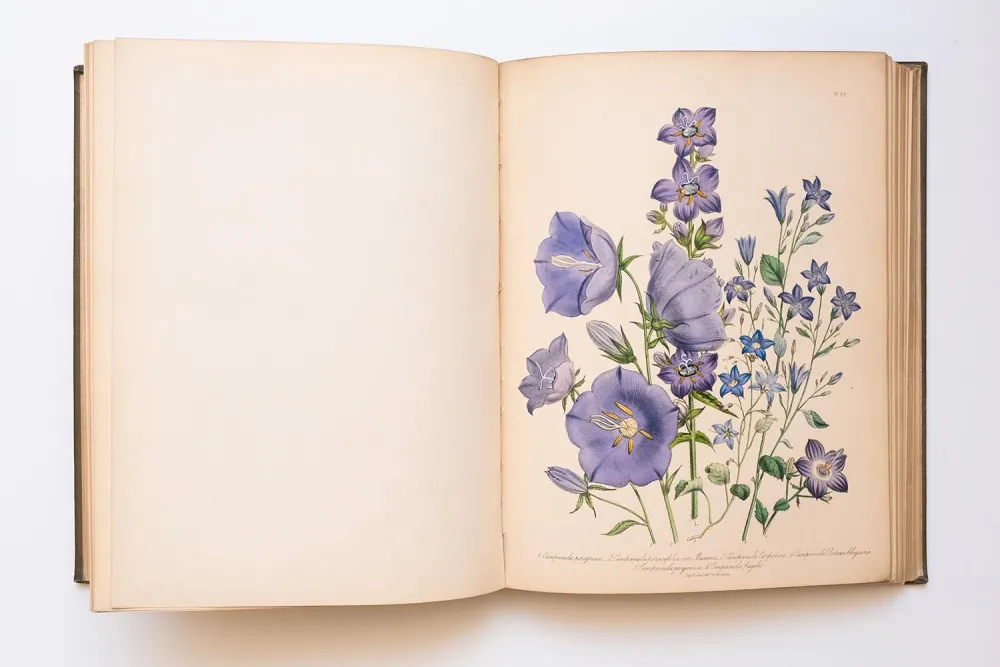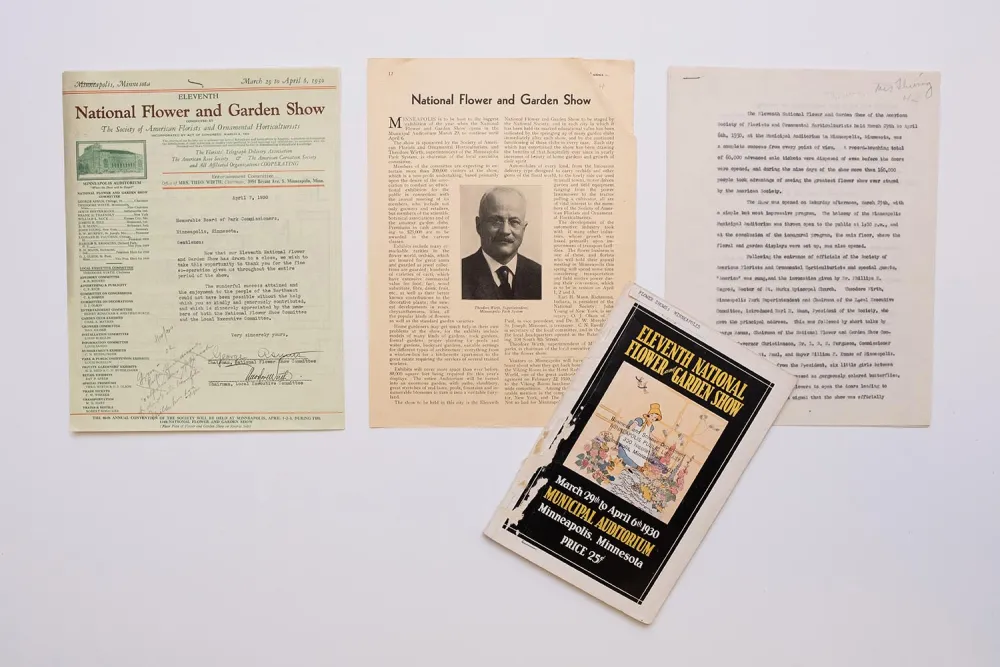
Figures of the Most Beautiful, Useful and Uncommon Plants
Philip Miller (English, 1691-1771)
Printed by John Rivington (London), 1760
Spencer Natural History Collection
This two-volume work includes three hundred hand-colored engravings printed from copper plates. Miller originally intended to publish a book of plants for every known genus, but abandoned this plan to include only those “which may be useful in trades, medicine, etc.” The work was published by subscription in 50 monthly parts, with each part containing 6 plates, between March 1755 and June 1760. Complete sets of this edition are scarce.

Miller originally intended to publish a book of plants for every known genus.

This two-volume work, Figures of the Most Beautiful, Useful and Uncommon Plants, includes three hundred hand-colored engravings.

The engravings of the illustrations were printed from copper plates.

The book was originally published by subscription in 50 monthly parts. Each contained 6 plates.

The work was published between March 1755 and June 1760. Complete sets of this edition are rare.

Medicinal Plants
Robert Bentley (English, 1821-1893) and Henry Trimen (English, 1843-1896)
Spencer Natural History Collection
Both Bentley and Trimen were trained in medicine and eventually became botanists. Herbal remedies tied botany to medicine for centuries. Consequently, botanical art is in part an outgrowth from the study of the medicinal attributes of various plants as recorded and illustrated in herbals. The 4-volume set includes over three hundred hand-colored plates by botanist David Blair. In order to preserve this brittle set, the hand-colored plates were removed from the books and edges were repaired and reinforced with special archival paper adhesive. The original text was preservation photocopied and rebound.

This 4-volume set by David Blair includes over 300 hand-colored plates.

To preserve Medicinal Plants, the plates were removed from the books and the edges were repaired and reinforced with special archival paper adhesive. The original text was preservation photocopied and rebound.

The True Amazons, or The Monarchy of Bees
Joseph Warder (English, before 1655-1718)
Printed for T. Longman and T. Astley (London), 1742 (7th ed.)
Spencer Natural History Collection
The Management of Bees
Samuel Bagster (English, 1800-1835)
Published by S. Bagster and W. Pickering (London), 1834
Spencer Natural History Collection
Interest in urban beekeeping has grown in the last decade and many cities have recently approved ordinances to allow for backyard hives, but beekeeping dates back thousands of years. Joseph Warder made a special study of the habits of bees, and in 1693 he compiled the results of many years of observation in this treatise. It was considerably advanced in its research and contained many curious particulars concerning the habits of bees and instructions for their management. A century later, Samuel Bagster, well read in the natural history of bees, published his book on bee management, describing the work of apiarists past and contemporary.

Beekeeping dates back thousands of years. Joseph Warder made a special study of the habits of bees, compiled in 1693 in this edition of The True Amazons, or The Monarchy of Bees.

A century later, Samuel Bagster published his book, The Management of Bees.

Bagster's book describes the work of apiarists like Warder, both past and contemporary.

The Ladies’ Flower-Garden of Ornamental Perennials
Jane Loudon (English, 1807-1858)
Published by W. Smith (London), 1843-1844
Spencer Natural History Collection
Loudon wrote the first popular gardening manuals for the everyday woman and was also a writer of Gothic fiction, fantasy, horror, and some of the earliest science fiction. Later in life she became a self-taught, acclaimed botanical artist. Loudon learned about plants and gardening while assisting her husband, horticulturalist John Claudius Loudon, with his work. Her plain-language gardening manuals sold in the thousands to women all over the country who were encouraged to take up gardening as a hobby.

Jane Loudon, the author of the first popular gardening manuals for the everyday woman, The Ladies’ Flower-Garden of Ornamental Perennials, also wrote Gothic fiction, fantasy, horror, and some of the earliest science fiction.

Loudon was a self-taught botanical artist who learned about plants and gardening while assisting her husband, horticulturalist John Claudius Loudon.

Her gardening manuals sold in the thousands to women all over the country.

Familiar Lectures on Botany
Almira Hart Lincoln Phelps (American, 1793-1884)
Published by H. and F. J. Huntington (Hartford, Conn.), 1829
Spencer Natural History Collection
Phelps was an educator and writer who aimed to raise the academic standards of education for girls and women. This botany textbook was the first of several science texts published by Phelps on botany, geology, natural philosophy, and chemistry. For over three decades she taught at and directed several female seminaries and institutes on the East Coast. In 1859 she became the second woman to be elected to the American Association for the Advancement of Science.
The Herball or Generall Historie of Plantes
John Gerard (English, 1545-1612)
Printed by A. Islip, J. Norton & R. Whitakers (London), 1633 Spencer
Natural History Collection
This pre-Linnean work was first published in 1597 and was the most prevalent botany book in English of the 17th century. It is known to be largely an English translation of Flemish botanist Rembert Dodoen’s herbal text published in 1554, though Gerard claimed the work was his own, leading him to be accused of plagiarism. The book includes hundreds of high-quality printer’s woodcuts derived from throughout Europe and reused from many 16th century botanical books. This corrected and expanded edition was published two decades after Gerard’s death.

Published in 1597, Gerard's book The Herball or Generall Historie of Plantes was the most prevalent botany book in English of the 17th century.

Almira Hart Lincoln Phelps' book Familiar Lectures on Botany includes hundred of high-quality printer's woodcuts derived from throughout Europe.

Eloise Butler Wildflower Garden
Minneapolis History Collection
Thank you note from Minneapolis Park and Recreation Board Records (M/A 324)
Photographs from Collection on the Eloise Butler Wildflower Garden and Bird Sanctuary (M/A 368)
In 1907, retired botany teacher Eloise Butler and other nature enthusiasts petitioned the Minneapolis Board of Park Commissioners to create the first public wildflower garden in the United States. When the garden opened in Glenwood Park (now Theodore Wirth Regional Park), Butler became its guardian, first as a volunteer and then as a paid curator. Recognizing her love of the garden and her commitment to its vitality, the park board named the garden after Eloise Butler in 1929. Butler sent this thank you note to the park commissioners saying, in part, that “[w]hat I have done has been entirely from love for the work and without thought of reward; but I cannot help feeling proud and gratified that my work should be deemed worthy of public recognition.”

Eloise Butler, for whom the Eloise Butler Wildflower Garden was named, sent a thank you note to the park commissioners saying that "what I have done has been entirely from love for the work."

Lee Garden Scrapbook, 1974-1991
Minneapolis History Collection
Muriel Lee Collection on Caesar's Bar and the Cedar-Riverside Neighborhood (M/A 313)
Muriel and David Lee used this scrapbook to document the garden they maintained across the street from their business—Caesar’s Bar—in the Cedar-Riverside neighborhood. The book includes annual planting plans for the garden, photos of the flowers in bloom, and praise for the garden from local residents and news media.

Muriel and David Lee documented the garden they maintained across the street from their business in a scrapbook.

The book includes annual planting plants, photos of flowers in bloom, and praise for the garden from residents and news media.

11th National Flower and Garden Show, 1930
Minneapolis History Collection
Program from Collection on the Minneapolis Auditorium (M/A 100)
Thank you letter and narrative from Minneapolis Park and Recreation Board Records (M/A 324)
From March 29 to April 6, 1930, Minneapolis hosted the nation’s largest flower show. The Minneapolis Auditorium hall was covered with displays of familiar and exotic vegetation. For the 25-cent admission fee, guests could enjoy Japanese, Italian, English, and even sunken gardens. A rare Cypripedium orchid was flown in from Massachusetts—no small thing in 1930—to bloom during the show. The Board of Park Commissioners (now the Minneapolis Park and Recreation Board) was an important partner of the event and received this note written on the event’s ornate letterhead.

The Board of Park Commissioners received this note following Minneapolis's hosting of the nation's largest flower show in 1930.